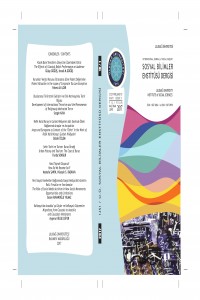Abstract
In this article, instead of examining burial customs or rituals throughout the ages, it is aimed to understand how the human body is transformed back to the soil especially after the seed burial, by examining the human bones collected from the same geographical region of different periods.
It should be noted that the bones we collect for examination are in particular from the South Marmara Region and from different time periods. This study also shows that the duration of the bones in the soil and the secondary occurrences on the bones, especially the density of hydroxyapatite, are directly proportional. This result suggests that it may be possible to determine the period when the bones belong to the same studies carried out on the inner/por surfaces of the bone finds, in other words, perhaps this method could also be used for dating.
References
- Arsebük, Güven, (2002). “Evrimi Kendine Özgü Bir Canlı: İnsan”. Colloquium Anatolicum I, 1-24.
- Boyraz, D.; Başkaya, Hüseyin Savaş; Akşit, İ.; Arocena, J.; Polat, S.; Dingil, M.; Şahin, Mustafa; Şahin, Derya; Kaynak, G.; Akay, S. K.; Yılmaz, Özer; Akça, E.; Biçici, M.; Kapur, S.; (2011). “Preliminary Submicroscopy of a Vertebral Bone Fragment from a Bithynian Tomb of 2nd Century B.C. in Bursa, Western Turkey”. TÜBA-AR 14, 151-158.
- Hançerlioğlu, Orhan, (1978). Felsefe Ansiklopedisi V. İstanbul: Remzi Kitabevi.
- Leroi-Gourhan, André, (1975). “The Flowers found with Shanidar IV, A Neanderthal Burial in Iraq”. Science, 190, 562-564.
- Lewin, Roger, (1998). Modern İnsanın Kökeni, (çev.) N. Özüaydın, Ankara: Tübitak Yayınları.
- Scheffer, F.; Schachtschabel, P., (1976). Lehrbuch der Bodenkunde. Stuttgart.
- Solecki, Ralph S, (1975). “Shanidar IV, A Neanderthal Flower Burial in Northern Iraq”. Science, 190, 880-881. Şahin, Mustafa, (2009). “Görükle Mezarı Kurtarma Kazısı 2006 Yılı Sonuç Raporu”. 30. Kazı Sonuçları Toplantısı, 1, Ankara, 25 - 38.
- Uhri, Ahmet, (2006). “Batı Anadolu Erken Tunç Çağı Ölü Gömme Gelenekleri”, (Yayınlanmamış Doktora Tezi), Ege Üniversitesi Sosyal Bilimler Enstitüsü, İzmir.
- Uhri, Ahmet, (2010). Anadolu’da Ölümün Tarih Öncesi Bir Geleneğin Oluşum Süreçleri. İstanbul: Ege Yayınları.
Abstract
Bu makalede, çağlar boyunca gömü geleneklerini veya ritüellerini irdelemek yerine, özellikle inhumasyon defin sonrasında insan bedeninin tekrar toprağa nasıl dönüştüğünü, değişik dönemlere ait aynı coğrafyadan toplanan insan kemiklerinin incelenmesi suretiyle anlamak hedeflenmektedir.
İnceleme amacıyla topladığımız kemiklerin özellikle Güney Marmara Bölgesi’nden ve değişik zaman dilimlerinden olmasına dikkat edilmiştir. Yapılan bu çalışma, ayrıca, kemiklerin toprak altında kalma süresi ile kemikler üzerindeki sekonder oluşumların, özellikle hidroksiapatitin yoğunluğunun doğru orantılı arttığını göstermektedir. Bu sonuç, kemik buluntularının iç/por yüzeylerinde yürütülecek benzer çalışmalar ile kemiklerin ait olduğu dönemin belirlenmesinin mümkün olabileceğini, diğer bir ifade ile tarihleme konusunda belki bu yöntemin de kullanılabileceğini düşündürmektedir.
References
- Arsebük, Güven, (2002). “Evrimi Kendine Özgü Bir Canlı: İnsan”. Colloquium Anatolicum I, 1-24.
- Boyraz, D.; Başkaya, Hüseyin Savaş; Akşit, İ.; Arocena, J.; Polat, S.; Dingil, M.; Şahin, Mustafa; Şahin, Derya; Kaynak, G.; Akay, S. K.; Yılmaz, Özer; Akça, E.; Biçici, M.; Kapur, S.; (2011). “Preliminary Submicroscopy of a Vertebral Bone Fragment from a Bithynian Tomb of 2nd Century B.C. in Bursa, Western Turkey”. TÜBA-AR 14, 151-158.
- Hançerlioğlu, Orhan, (1978). Felsefe Ansiklopedisi V. İstanbul: Remzi Kitabevi.
- Leroi-Gourhan, André, (1975). “The Flowers found with Shanidar IV, A Neanderthal Burial in Iraq”. Science, 190, 562-564.
- Lewin, Roger, (1998). Modern İnsanın Kökeni, (çev.) N. Özüaydın, Ankara: Tübitak Yayınları.
- Scheffer, F.; Schachtschabel, P., (1976). Lehrbuch der Bodenkunde. Stuttgart.
- Solecki, Ralph S, (1975). “Shanidar IV, A Neanderthal Flower Burial in Northern Iraq”. Science, 190, 880-881. Şahin, Mustafa, (2009). “Görükle Mezarı Kurtarma Kazısı 2006 Yılı Sonuç Raporu”. 30. Kazı Sonuçları Toplantısı, 1, Ankara, 25 - 38.
- Uhri, Ahmet, (2006). “Batı Anadolu Erken Tunç Çağı Ölü Gömme Gelenekleri”, (Yayınlanmamış Doktora Tezi), Ege Üniversitesi Sosyal Bilimler Enstitüsü, İzmir.
- Uhri, Ahmet, (2010). Anadolu’da Ölümün Tarih Öncesi Bir Geleneğin Oluşum Süreçleri. İstanbul: Ege Yayınları.
Details
| Journal Section | Articles |
|---|---|
| Authors | |
| Publication Date | July 13, 2017 |
| Submission Date | April 6, 2017 |
| Published in Issue | Year 2017 Volume: 10 Issue: 1 |
---------------------------------------------------------------------------------------------------------------------------------------------------

Content on this site is licensed under a Creative Commons Attribution 4.0 International license.
---------------------------------------------------------------------------------------------------------------------------------------------------


